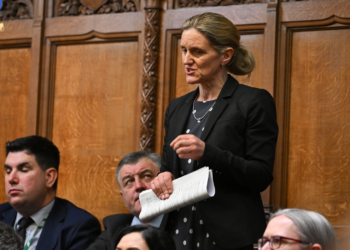Dillon Smith is Head of Energy & Environment at the Centre for Policy Studies.
In July last year, the Labour party swept into power with Ed Miliband promising the country £300 off their energy bills by 2030. But just over a year later, things aren’t exactly going to plan – as yesterday’s announcement from Ofgem on increasing the energy price cap illustrates.
Whereas an average household on the price cap was paying £1,568 at the time of the election, today that number is already £1,720 and from October we now know it will be £1,755 – increases of 10 per cent and 12 per cent respectively on July 2024.
This is far outpacing wage growth, (just 5 per cent in the year to June), with energy bills set to cut further into disposable incomes.
Our power prices are also high relative to our peers, both for households and especially for industry. This is fast becoming a national emergency, hugely undermining our competitiveness – what energy-intensive industry would want to set up shop in Britain?
To be fair, not all of this is within the Government’s control – one of the biggest determinants of our bills is gas prices, which are linked to European (and global) markets. But what’s particularly worrying about Labour’s energy strategy is that its flagship policy – Clean Power by 2030 – risks pushing bills up, not down, by sprinting furiously towards an extremely stretching target.
The whole endeavour was ill-conceived from the start, designed to suit a political target of decarbonising the grid five years before the Tories, with sums that didn’t add up (as the CPS warned during the election campaign). And indeed the system operator’s ‘independent’ modelling underpinning the whole project bordered on farcical, using very aggressive assumptions simply to justify that costs would not increase as a result of the plans.
The report laid bare just how difficult reaching Clean Power by 2030 would be.
For a start, it requires building twice as much transmission network capacity in the next five years as was built in total over the last decade – (with zero delays!) while increasing demand flexibility by 4-5 times from existing levels. And this was only possible by Labour defining ‘clean’ rather generously as 95 per cent non-fossil fuel not 98 per cent or 100 per cent.
But Labour has now very publicly committed themselves to 2030 – there’s no backing out now. And to hit that requires a huge ramp up in renewables – taking offshore wind capacity from 15GW to 43-50GW, and solar from 17GW to 45-47GW. Which means the next two renewables auction rounds will be crucial – Labour has to secure a certain amount of capacity, otherwise the target is lost. Therein lies the risk – the Government has painted itself into a corner, and will have to pay whatever it takes to secure the necessary wind and solar farms.
Unfortunately, the Government’s timing could hardly be worse. Globally offshore wind in particular has been struggling over recent years with supply chain constraints and rising costs. With interest rates remaining high, the cost of capital is also a huge issue. Renewables are capital-intensive, requiring high up-front investment with returns stretched out over many years. By going hell for leather on renewables now, the Government risks locking in higher prices for consumers as producers pass on high capital costs. Indeed, in a worrying sign, the Government recently raised the maximum price it is willing to pay for offshore wind in the upcoming auction.
Labour is clearly aware of the symbolism of this year’s auction prices and is changing a number of the auction rules to try to engineer lower prices, such as extending the contract term from 15 to 20 years, splitting out (more expensive) Scottish offshore wind from English projects, and letting unconsented offshore projects bid into the round.
So predicting where prices will shake out is especially difficult this year. But it’s all in the context of the all-consuming needs of 2030, rather than what is cheapest for consumers or best for the system.
That’s because for Labour, and the believers in the 2030 mission, it’s almost an article of faith that gas is expensive and renewables are cheap – regardless of the wider system costs (backup, grid and so on) and the actual prices consumers are paying in the auction rounds. As the CPS has pointed out, renewables are inherently neither cheap nor expensive – it depends how you build them, and what the gas price is.
So if the pace of the 2030 goal pushes the costs of renewables (and the wider system) up, and the gas price falls (as many believe it will), then we’ll have locked ourselves into even higher costs than today – and consumers will be stuck with those (not particularly cheap) renewables contracts for 20 years.
Yet the contortions necessitated by the 2030 target don’t stop there. Witness Labour’s climbdown on the ‘locational pricing’ debate. Renewables developers clearly hated the idea, and knew they had the Government over a barrel with the 2030 target. Or look at the move to handpick which projects will get grid connections according to what the Government believes is strategically necessary, rather than first come, first serve. It’s 2030 or bust, regardless of the consequences.
It’s also not as if there’s some great climate benefit at play – as a green conservative (a rare breed at this point, I know) even I think marginal CO2 benefits do not outweigh the risks and cost (especially given cheap electricity will be key to widespread EV and heat pump adoption).
We should be laser focused on the cheapest emissions reductions, and single-mindedly grinding down our gas usage towards zero is the opposite of that. Taking the ‘hair shirt’ approach for the sake of virtue signalling is both economically ruinous and environmentally unnecessary, especially with the growing international market for carbon credits – the planet could not care less where a tonne of CO2 is emitted or by whom: a tonne of CO2 is still a tonne of CO2.
Now there have been some bright spots in the last year: The Planning & Infrastructure Bill is nowhere near ambitious enough but is at least a step in the right direction. Labour has also finally started to see the light on nuclear, approving Sizewell C’s FID and the SMR competition – though neither will make any difference to the energy mix before the 2030s.
Overall however, Labour’s record on energy since the election can only be said to be a poor one.
A year is a short amount of time in energy policy of course, and the movements of international gas prices are beyond the Government’s control.
But Labour still seems to be driven primarily by ideology, rather than affordability. Unfortunately, it is households and businesses who will pay the price for Ed Miliband’s tunnel vision.


![Steak ’n Shake Mocks Cracker Barrel Over Identity-Erasing Rebrand [WATCH]](https://www.right2024.com/wp-content/uploads/2025/08/Steak-n-Shake-Mocks-Cracker-Barrel-Over-Identity-Erasing-Rebrand-WATCH-350x250.jpg)




![Human Trafficking Expert Details Horrific Biden Admin Endangerment of Migrant Kids [WATCH]](https://www.right2024.com/wp-content/uploads/2025/07/Human-Trafficking-Expert-Details-Horrific-Biden-Admin-Endangerment-of-Migrant-350x250.jpg)

![Mount Rushmore Could Get Trump Upgrade Under GOP Push [WATCH]](https://www.right2024.com/wp-content/uploads/2025/07/Mount-Rushmore-Could-Get-Trump-Upgrade-Under-GOP-Push-WATCH-350x250.jpg)
![Soros Network, Others Behind LA Riots [WATCH]](https://www.right2024.com/wp-content/uploads/2025/06/Soros-Network-Others-Behind-LA-Riots-WATCH-350x250.jpg)





